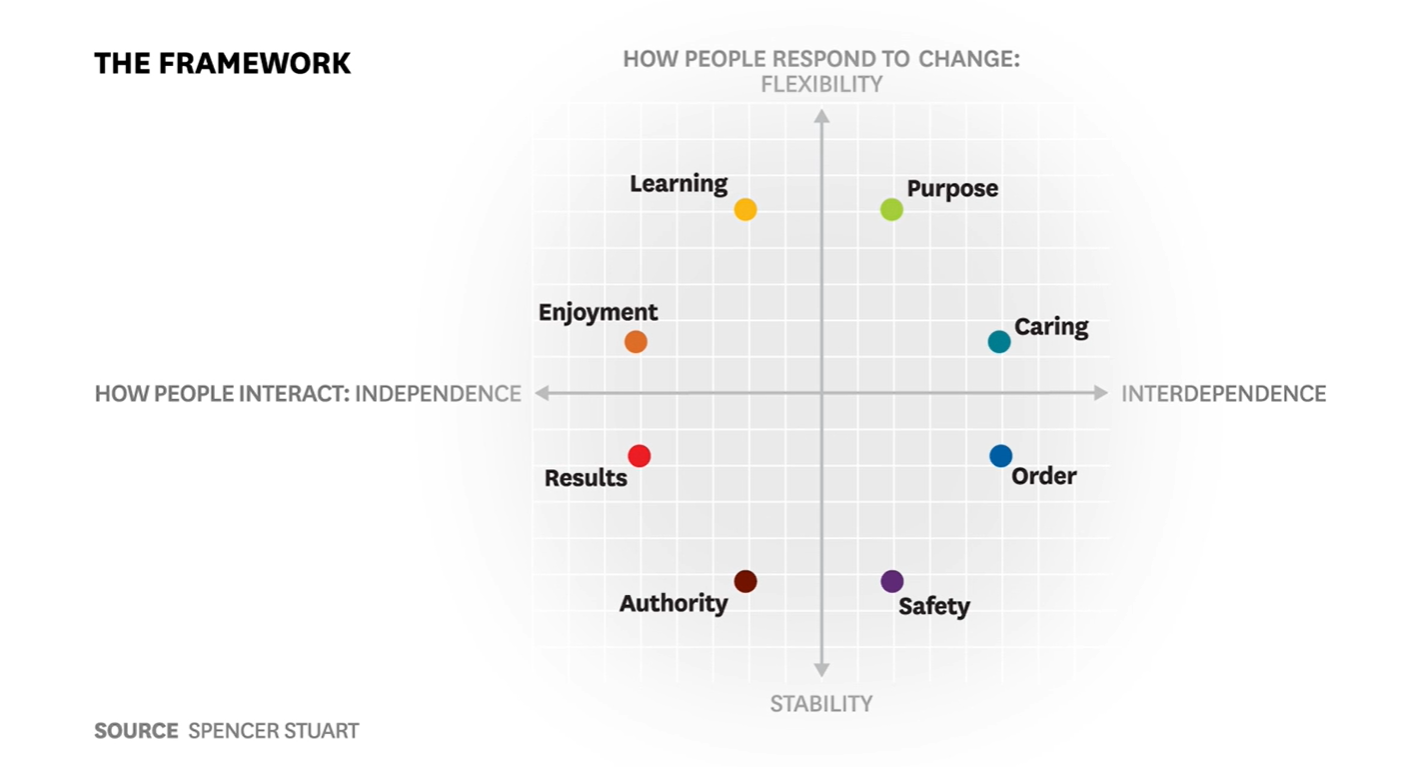.jpg)


Team culture in an organisation is the most important element in success. In today’s shaky employment environment, culture is King and Queen when it comes to building a successful organization that is innovative and resilient. A culture where everyone feels safe, comfortable, and like they belong is one of the most valuable assets a business can have. But like everything in life - with great reward comes great work.
And yet, the vast majority (about 70% according to Margaret Heffernan) of companies that embark on trying to change their culture fail. Despite us knowing that culture is our secret sauce for success, most of us have no idea how to create it or maintain it.
“Numbers are comforting - income, expenditure, productivity, engagement, staff turnover - and create an illusion of control. But when we’re confronted by spectacular success or failure, everyone from the CEO to the janitor points in the same direction: the culture. Beyond measure and sometimes apparently beyond comprehension, culture has become the secret sauce of organizational life: the thing that makes the difference but for which no one has the recipe.”
Why is team culture so important?
Research shows that organizations with top quartile cultures see a return to shareholders 60% higher than median companies and 200% higher than those in the bottom quartile. So it literally pays to have a great culture. But according to the 2016 LinkedIn Global Survey, just over half (52%) of job seekers would decline a job offer if they didn’t know or agree with a company’s values or purpose (aka their culture).
And with more than 90% of employees are willing to sacrifice a portion of their lifetime earnings for greater meaning and purpose at work, the trillion-dollar questions are:
- How do organizations increase purpose for each employee?
- How do you reconnect your people to the beliefs and values of the organization?
- Who is responsible for building and maintaining team culture?
Culture in the workplace is a non-linear system.
As we’ll see a little later, there are different types of culture in an organisation. Each team should have the autonomy to decide what is important for them to focus on to allow the team members to do their best work.
Think about it… a production team tasked with building ‘units’ will focus on precision, efficiency, minimising errors, maximising efficacy - compared to the sales team tasked with 'moving the units'; they will focus on narrative, storytelling, problem-solving, competitor analysis, pricing.
If the teams’ focus is different how could expect their cultures to be the same?
A teams culture is not just about what they do, it’s about how they do it and what they stand for.
Creating a team culture should be about capturing the purpose behind the work.
In this article we’ll cover what team culture is and isn’t, plus 8 strategies to help you build a great culture in your workplace.
Let’s jump in.
What is Team Culture?
Team culture is the shared values, beliefs, behaviours, habits, connection, and sense of belonging that define a group of individuals working together towards a common goal. It's the fuel that powers teams to drive forward and achieve success together.
Team culture is about building a resilient group of people who support each other, understand each other's strengths and weaknesses, and are able to easily pivot and adjust in a changing environment.
Unhealthy cultures do not respond well to change. McKinsey research shows that 70% of transformations fail, and 70% of those failures are due to culture-related issues.
A positive team culture fosters an environment of collaboration, trust, and respect, where team members feel comfortable expressing their ideas and opinions without fear of judgement.
But for it to work and be sustainable, you need active participation from every team member.
What typically happens in companies is a group, normally led by HR, are tasked with coming up with the values for the organisation that will drive the culture. There are lots of meetings to review research and see what has worked in other organisations.
The intentions are genuine and the output is usually some lofty aspirations that on the surface make the company appear authentic, caring, ethical and a great place to work.
“Putting people first” and other catchphrases will appear painted on the wall or in the header of the staff bulletin.
This is not creating culture.
As Margaret outlined earlier despite these lofty, authentic, caring, and ethical intentions, projects aimed at improving company culture fail 70% of the time.
It is totally unrealistic to believe that a whole organisation with a variety of different functions and priorities can focus on the same things.
Team culture should be the focus, not company culture.
What Team Culture Is Not
Team culture is not something that can be imposed from the top down or copied from another company. It’s not free snacks in the kitchen, lunchtime pilates classes, or having a team that is all the same. It’s not just about the nice “fluffy” stuff. It’s about building a team that embraces diversity, encourages individuality, and does great work - together.
Team culture is also not about avoiding conflict, it’s about being open to challenging conversations and trusting that you and your team will handle them in a respectful and productive way.
So now we’ve covered what team culture is and isn’t, let’s jump in and see how to build and maintain it.
How to Build a Great Team Culture in Your Workplace
If you're looking for a quick fix, sorry to break it to you but building a great team culture won’t happen overnight. And once you’ve built it to something everyone’s proud to be part of, you’ve got to work even harder to maintain it.
I guess what I’m getting at is, building a great team culture isn’t about reaching a destination. Yes, goals and milestones are always important, but there’s never an end to it. The only objective is to keep improving.
So whether you have an awesome team culture and you’re maintaining or you know there’s room for improvements in your organization (kudos for being here), here are some strategies to help you and your team.
Here are 8 tips on how to build a great team culture that everyone feels a part of:
- Encourage an open culture.
- Match team values to goals.
- Honor individuals, recognize accomplishments, and reward performance.
- Work together and help one another out at all levels.
- Communicate consistently and clearly on a regular basis.
- Encourage respectful communication between team members.
- Establish trust by being reliable and honest.
- Clearly define the objectives and expectations for the team's projects and tasks.
1. Encourage an open culture.
Create an environment where team members feel comfortable expressing their thoughts and ideas without fear of judgement. Encourage open communication and feedback at all levels, as it helps team members understand their strengths and weaknesses, and enables them to work collaboratively towards common goals.
2. Match team values to goals.
It's important to align your team values with your goals and objectives. When everyone’s working towards the same vision, it creates a sense of unity, connection and purpose. This alignment helps team members prioritize tasks and stay focused, ultimately leading to greater productivity and success.
3. Honor individuals, recognize accomplishments, and reward performance.
Acknowledge and appreciate the efforts of individual team members and the team as a whole. Celebrating successes together and rewarding performance encourages, motivates, and engages everyone in the team. This not only builds team morale, but also fosters a sense of belonging and camaraderie.
4. Work together and help one another out at all levels.
Create a culture where team members are willing to lend a hand and support each other. Encouraging collaboration and teamwork at all levels helps to build strong relationships, improves communication, and increases trust.
5. Communicate consistently and clearly on a regular basis.
Clear and consistent communication is critical to building trust and maintaining a positive team culture. Ensure that communication is open, honest, and transparent, and that team members are kept informed about important decisions, changes, and progress updates. Your internal comms are just as important as your external comms.
6. Encourage respectful communication between team members.
Create an environment where team members feel respected and valued, and where communication is respectful and professional. Encourage team members to actively listen to each other, seek to understand different perspectives, and to communicate in a constructive and supportive manner.
7. Establish trust by being reliable and honest.
Trust is the foundation of a positive team culture. Be reliable and honest in your interactions with team members, and encourage the same behavior from others. It will help you build credibility, integrity, and respect amongst the team.
8. Clearly define the objectives and expectations.
Clear objectives and expectations provide direction and focus, and help team members understand everyone’s roles and responsibilities. This clarity enables team members to work towards common goals with clarity, ultimately leading to greater productivity and success.
How to build an effective team culture
Building a team culture is not about starting with a lofty goal that makes your company sound cool.
Equally, it is not about defining an outcome and working towards that goal.
Rather, it should start with providing purpose and meaning to the work that people are doing.
In 2011, the American Career Advisory Board ran the largest study of its kind, designed to understand the career aspirations of the millennial generation. The perception held by older managers was that money and status were the main drivers for this younger generation.
What they found was the actual views of millennials themselves pointed to something far more crucial and interesting. 75% of the surveyed employees between the ages of 21 and 31 said that having a career with a sense of purpose and meaning was most important to them.
For people to generate their best performance they need to feel connected and engaged with purpose and meaning. This is true irrespective of the arena. This is not how just Google employees work or how the All Blacks play. It is how people, at their best, work and play.
How to build a team culture?
So… How do you create a team culture that is a just culture and promotes psychological safety? This might seem harder than it is.
Google asked itself a similar question in 2012 - what are the common denominators in high-performing teams. We immediately think of technical experience, years on the job, qualifications, seniority, awards and accreditations. However, none of these is a real dial mover.
Project Aristotle, as it was known, studied hundreds of Google’s teams to try and work why some succeeded while others failed. They analysed 180 teams across the organisation and gathered some of the company’s best statisticians, organisational psychologists, sociologists and engineers to pour over the data.
The findings pointed towards three common denominators in high-performing teams.
- Equality - everybody on the team had equal opportunities and time to talk
- Contribution - when people talked they felt the group was listening and they were heard
- Empathy - the better teams had a high average social sensitivity - being able to recognise how others felt based on their tone of voice, their expressions and other nonverbal cues.
The researchers also found that all of their conclusions were backed by previous academic research.
These three common denominators extended beyond work discussions. High-performing teams share their personal lives and experiences in the work setting. And guess what, it makes the whole group better, closer and more ready to do great work.
Now, if you are a manager of people or a leader at your organisation, think about how many times in your workweek you have a group of people together?
Do they all get a chance to speak?
How are good ideas handled?
More importantly, how are the bad or unpopular ideas and suggestions handled?
And, how often does the group share personal stories about themselves?
If leaders focus on these for some time, there is a weight of evidence to suggest the team performance will improve.
How do you improve team culture?
If we think back to what we said at the top of this article, team culture should be the focus, not company culture.
It is totally unrealistic to believe that a whole organisation with a variety of different functions and priorities can focus on the same things.
Within each team environment, managers and leaders should try the following.
- At least once a month, create a group or meeting will the sole purpose of focusing on Equality, Contribution, and Empathy that worked in Google and other organisations.
- For all meetings test different structures, meeting cadences, and methods of running meetings to allow Equality, Contribution, and Empathy to come out.
- Compare what works and doesn’t work for your team with what other teams are doing AND…
- Share with other teams what you have tried and tested.
- Iterate on your processes and adopt new methods and ideas to keep things fresh making sure that Equality, Contribution, and Empathy are always to the fore in group settings.
Part of our PepTalk program includes a monthly TeamTalk that gives managers and leaders guidance on a once a month meeting that will focus on non-business as usual matters.
It provides the perfect opportunity to do #1 from the list above. This video gives an outline of how you could run a TeamTalk.
While the focus on team culture will improve teamwork, it is important that all teams come together and that the whole organisation benefits from the just culture and psychological safety.
If teams begin to operate in vacuums, silos will be built up and reinforced.
The key to ensuring the organisational benefit is to have the whole organisation from the C-suite to individual team members all involved in creating the just culture.
In Beyond Measure, Margaret Heffernan sums up the need for organisational wide involvement perfectly.
“Culture has become the alibi, the scapegoat, for everything that is wrong. But who can fix it? Only everyone.”
Types of team culture
There are many different types of team cultures.
Whatever route you go down it is important that team culture are aligned to each teams' purpose and not driven by business outcomes.
For example, the Harvard Business Review outlined work by a team of researchers that came up with eight types of company cultures that it measures across 2 axes
- how people interact and
- how people respond to change
A good place to start would be to review where your current culture is and consider what you need to change to create a more desirable team culture.
The main attributes of each culture are (% of companies in the study ranked this as an organisational priority)
- (63%) Caring - big on relationships, collaboration and trust.
- (9%) Purpose - idealists, tolerant, compassionate and doing good for the long-term future of the world.
- (7%) Learning - adventure, curious, inventive and open-minded where explore alternatives.
- (2%) Enjoyment - playfulness and stimulation; leaders emphasize spontaneity and a sense of humour.
- (89%) Results - achievement and goal accomplishment.
- (4%) Authority - strength, decisiveness, confidence and dominance.
- (8%) Safety - predictable, planning, caution, and preparedness.
- (15%) Order - respect, structure, procedures and time-honoured customs.

By auditing your team you can choose the cultures based on whether your people are more independent or interdependent when they work. And whether they welcome stability or flexibility concerning change. This will allow you to understand what team culture is most important to uphold but also which ones are likely to be sustained.
Making it happen - The 1% Rule
I think the main reason why 70% of culture change projects fail is because of unreasonable expectations. Let’s face it, that’s why most projects fail.
Team culture is like running a marathon - it won’t happen overnight. It will take time and gradual progress to reach a point where the idea becomes achievable.
In the same way, you wouldn’t do a handful of training runs and expect to be able to complete 42 kilometres, a few people and a few more meetings won’t create a team culture that works.
It will be hard and it is not a matter of if the resistance will come, it’s when.
And this is where the magic will happen. In a just culture brimming with psychological safety, your people will be able to stand up and tell you where the problem is and as a group, you’ll come up with lots of ways to fix it.
Frequently Asked Questions


See PepTalk in action


Related
Latest Blogs


See PepTalk in action






.jpg)

.jpeg)

.jpg)
%20(3).jpg)
.jpg)


.jpg)
.jpg)